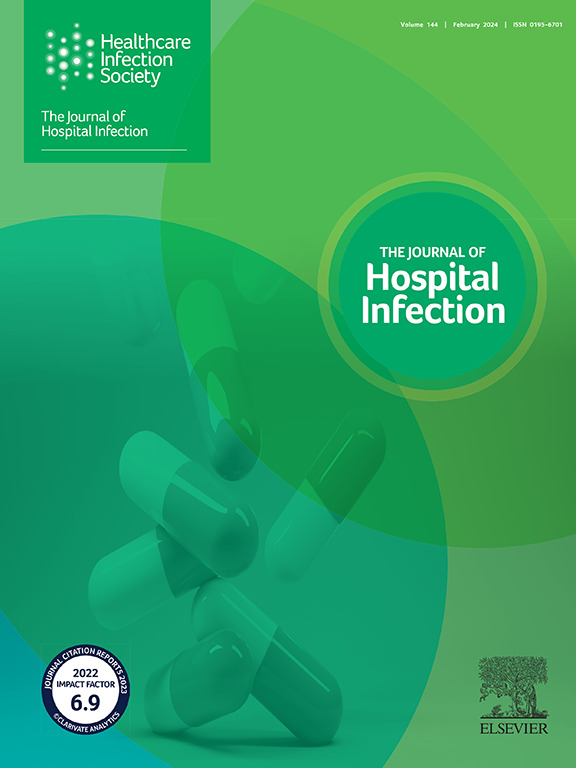VanB transposon analysis detects horizontal gene transfer in vancomycin-resistant Enterococcus faecium: description of two outbreaks
IF 3.1
3区 医学
Q1 INFECTIOUS DISEASES
引用次数: 0
Abstract
Background
Outbreaks with vancomycin-resistant Enterococcus faecium (VRE) are common in hospitals worldwide. Whole-genome MLST (wgMLST) is often used to identify outbreak strains, but VRE typing can still be challenging due to their limited genomic variation.
Aim
Developing a method for sequence analysis of vancomycin resistance genes in parallel with wgMLST and application of this new method for real-time investigation of two parallel VRE outbreaks.
Methods
A bioinformatics pipeline was developed to compare the sequences of transposons containing vanB resistance genes. This pipeline was used in addition to wgMLST to investigate two separate ongoing VRE outbreaks. Five separate colonies from 15 different samples and 10 vancomycin-susceptible isolates were also sequenced.
Findings
Of 46 strains collected during two outbreaks, 26 and nine strains were identified as being part of the two outbreaks based on wgMLST clustering. In six strains an identical vanB transposon but a different wgMLST cluster were identified, indicating horizontal gene transfer. This potential outbreak spread would have been missed without transposon analysis. There was no evidence of variability in vanB transposon sequence or wgMLST profiles within different colonies from the same sample. One vancomycin-susceptible E. faecium in blood culture was identified, with a wgST similar to one of the outbreak strains.
Conclusion
Real-time analysis of transposons containing vancomycin resistance genes provides additional information for analysis of vanB-VRE outbreaks. It detects possible horizontal gene transfer which would not be detected using conventional methods. Transposon analysis is a valuable addition to whole-genome sequence analysis during vanB-VRE outbreaks.
VanB转座子分析检测万古霉素耐药屎肠球菌的水平基因转移:两次暴发的描述。
背景:万古霉素耐药屎肠球菌(VRE)暴发在世界各地的医院中很常见。全基因组MLST (wgMLST)通常用于确定暴发菌株,但由于其基因组变异有限,VRE分型仍然具有挑战性。目的:建立与wgMLST平行的万古霉素耐药基因序列分析方法,并将该方法应用于两次平行VRE暴发的实时调查。方法:我们建立了一个生物信息学管道来比较含有vanB抗性基因的转座子序列。除了wgMLST之外,我们还使用该管道调查了两个单独的正在进行的VRE暴发。我们还对来自15个不同样品和10个万古霉素敏感分离株的5个独立菌落进行了测序。结果:在两次暴发期间收集的46株菌株中,我们根据wgMLST聚类鉴定出26株和9株属于两次暴发的一部分。在6株菌株中,我们发现了一个相同的vanB转座子,但不同的wgMLST簇,表明基因水平转移。如果没有转座子分析,就不会发现这种潜在的疫情传播。我们发现在同一样本的不同菌落中,vanB转座子序列或wgMLST谱没有变化。我们在血液培养中鉴定出1个对万古霉素敏感的粪肠杆菌,其wgST与爆发菌株之一相似。结论:实时分析含有万古霉素耐药基因的转座子为vanB-VRE暴发分析提供了额外的信息。它检测到可能的水平基因转移,这是传统方法无法检测到的。在vanB-VRE暴发期间,转座子分析是全基因组序列分析的重要补充。
本文章由计算机程序翻译,如有差异,请以英文原文为准。
求助全文
约1分钟内获得全文
求助全文
来源期刊

Journal of Hospital Infection
医学-传染病学
CiteScore
12.70
自引率
5.80%
发文量
271
审稿时长
19 days
期刊介绍:
The Journal of Hospital Infection is the editorially independent scientific publication of the Healthcare Infection Society. The aim of the Journal is to publish high quality research and information relating to infection prevention and control that is relevant to an international audience.
The Journal welcomes submissions that relate to all aspects of infection prevention and control in healthcare settings. This includes submissions that:
provide new insight into the epidemiology, surveillance, or prevention and control of healthcare-associated infections and antimicrobial resistance in healthcare settings;
provide new insight into cleaning, disinfection and decontamination;
provide new insight into the design of healthcare premises;
describe novel aspects of outbreaks of infection;
throw light on techniques for effective antimicrobial stewardship;
describe novel techniques (laboratory-based or point of care) for the detection of infection or antimicrobial resistance in the healthcare setting, particularly if these can be used to facilitate infection prevention and control;
improve understanding of the motivations of safe healthcare behaviour, or describe techniques for achieving behavioural and cultural change;
improve understanding of the use of IT systems in infection surveillance and prevention and control.
 求助内容:
求助内容: 应助结果提醒方式:
应助结果提醒方式:


